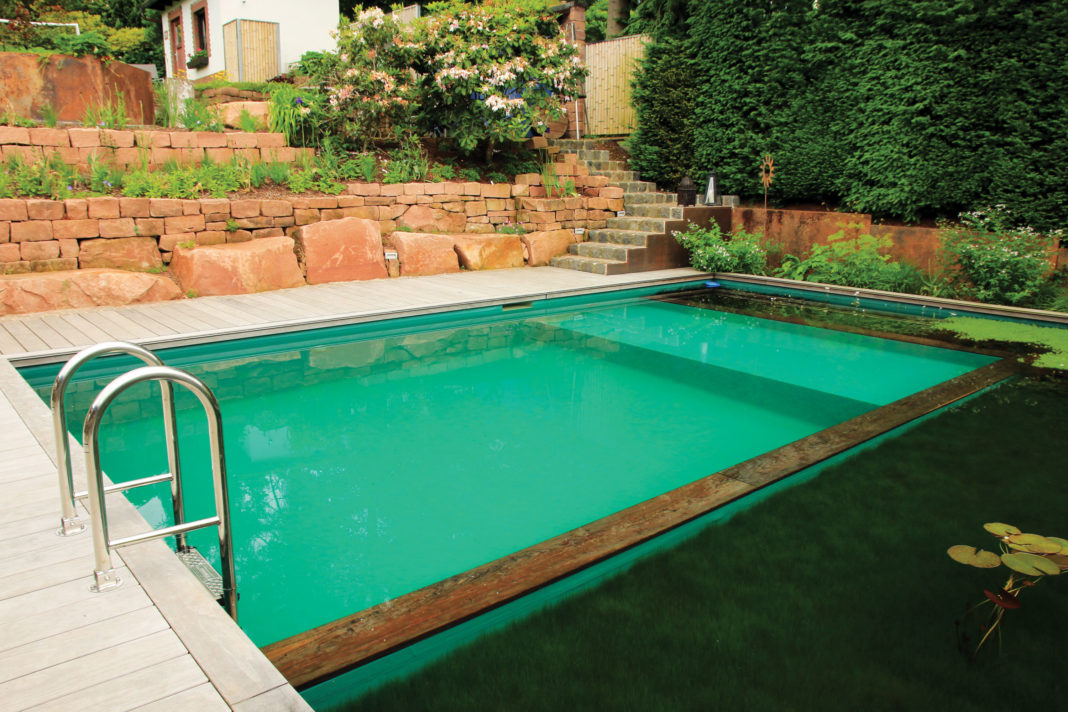An environmentally friendly alternative to a classic American tradition.
What is a natural pool?
The natural swimming pool movement is widely considered to have begun with Gottfried Kern in Austria around 1954. He was the first to partition his pools, creating shallow spaces called “regeneration zones” where plants and animals could live and grow undisturbed whilst still accessing the greater pool.
Today a natural swimming pool is defined by its mode of filtration, that is one of a biological foundation. Traditional chemical pools rely on high volume mechanical circulation pumps, continual chemical treatments or costly salt generators. True natural pools use air pumps to move water with bubbles, bacteria to process nitrogen, aquatic microfauna which consume algae and the nutrient absorbing properties of plants to create clean, clear, chemical free water that is safe for even the most sensitive to swim in and enjoy. By circulating water from the swimming zone through the planted regeneration zone we mimic the processes that take place in nature. In aquatic ecosystems, plants take up certain forms of nitrogen directly from the water into their tissues. Meanwhile bacteria that colonize the surface of pretty much everything in the pool break down other forms of nitrogen and convert them so they can be readily taken up by the plants or broken down even further by other types of bacteria.
There are some caveats however, the primary ones being time and space. Traditional pools take on average around 6-10 weeks to complete. Actual construction of a natural pool is roughly the same, the main difference being the creation of an ecosystem from scratch. This mind you is no short order. Once the pool has been built, filled and planted, you’ll then need to wait for the pool to cycle.
Cycling is the process in which bacteria colonize the pool by reproducing to a level significant enough to efficiently process the nutrients we add when we swim. Less significant but still important is the establishment of the plants themselves, producing new growth, extending their roots into their new location they start absorbing nutrients as well. The larger the pool, the longer it will take to complete the cycle. Generally, you can expect to wait 6-12 weeks for cycling to complete. During this time, it’s normal to see an algal bloom, particularly in the regeneration zone. It will subside as the plants begin to grow and the bacteria start processing nutrients.
Additional space will need to be allotted for the regeneration zone. Whether it is attached to the pool or located remotely, this zone should be roughly equal in surface area to the swimming zone in order for it to effectively filter the pool. A benefit of the regeneration zone is the passive heating it provides. By circulating cool water from the deeper swimming zone into the warmer regeneration zone we use the power of the sun to heat the pool. While this eliminates the need to warm the pool using traditional methods, saving money in the process, it does take longer for the temperature of the water to climb to a comfortable level for swimming.
The Path to Installation
The first step in creating a natural pool is going to be engaging a design professional with the mindset, knowledge and fortitude needed to guide a complex project to successful completion. They should have extensive experience in creating and maintaining aquatic ecosystems, thoroughly understand the nitrogen cycle and be able to relate it to you in a way that you can understand. As I’ve covered previously, the time invested in planning pays dividends in the long run. Nowhere is this truer than when we talk about complex installations like pools. Once you’ve selected a qualified designer or architect, finalized your plan, applied for and received approval for permitting, construction can begin.
Easily the most exciting part of the experience is construction. Watching skilled equipment operators finesse an excavator the size of your garage as they precisely cut contours to form the shape of your pool within inches of your home is something to behold. The erection of walls and placement of boulders or other stonework is equally remarkable with the benefit of being somewhat less nerve wracking to watch for the future pool owner. Finally, with the pool dug, walls and stonework completed the pool can be filled and planted. The plants must be stripped of their soil or other media and sterilized to ensure they are free of any additional nutrients or hitchhikers. When it comes to filling the pool you’ve got two options, bringing water in via a truck or filling it yourself with a hose. The average garden hose delivers about 9 gallons per minute. Supposing you built a 24,300-gallon pool, the volume of your average 18’x36’ pool, it would take you over 45 hours to fill. Getting your water delivered from a service can take you a fraction of the time, but it’s also going to cost more.
Maintenance in Mind
Routine, ongoing maintenance is really where pool owners reap the benefits of a natural system. Water testing is the cornerstone to understanding and maintaining proper chemistry in any pool and should be conducted regularly. Debris removal and regularly vacuuming the floor of the swimming zone is really all that’s required. Plants may need division as they fill out. Simply thinning with scissors or shears is all it takes to regain some balance. With a well-established pool the need for outside adjustments of the water chemistry should be almost non-existent.
Now that you understand a bit about what a natural pool is and what’s involved in owning one, I hope you’ll consider it if you happen to find yourself in the market. Its not an endeavor to take on lightly but the rewards can be absolutely amazing!
Our passion for natural systems and sustainable native spaces drives a lot of what we do at Green Slate Design. It comes through in our designs and our finished product. We strive to create diverse environments for our clients and all of their inhabitants. If you’re considering creating a natural pool, pond or other native space please take the time to educate yourself or hire a professional with experience in constructing the type of outdoor space that interests you most. You’ll take pride in the knowledge of having made a difference in a way that is meaningful for you, your family and the planet for generations.
Green Slate Design LLC
952-903-4902
www.greenslatedesign.com







